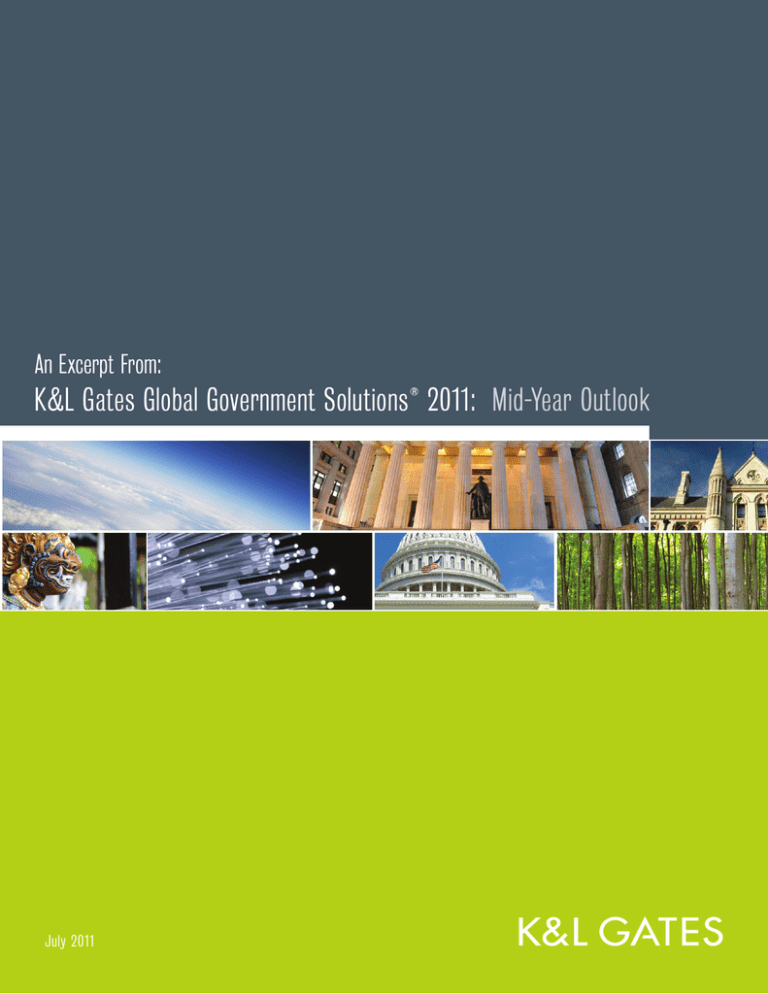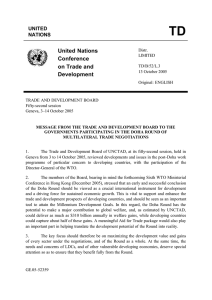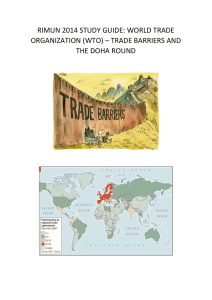
An Excerpt From:
K&L Gates Global Government Solutions ® 2011: Mid-Year Outlook
July 2011
Policy and Politics
To Doha or Not to Doha, That is the Question!
The current multilateral trading system was launched in 1947 with the signing
of the initial General Agreement on Tariffs and Trade (“GATT”) by 23 founding
members. Between 1947 and 1994, GATT evolved through a series of eight
multilateral negotiations, referred to as “trade rounds,” into a comprehensive array
of multilateral trade agreements reducing tariffs and non-tariff barriers.
On January 1, 1995, GATT, which by
then had 123 signatories, gave way to
the World Trade Organization (“WTO”).
The WTO was established not only
to continue to implement GATT and
to take over the process for reaching
further multilateral agreements, but also
to become the first formal organization
to oversee the multilateral trading
system. However, the WTO, which has
increased in membership to 153, has
yet to establish a solid track record of
trade round negotiations. The first WTO
trade round, the Doha Trade Round
(also known as the Doha Development
Agenda), was initiated in 2001, but no
agreement has yet been reached.
The following provides some background
on the Doha Round, an analysis of
the failure to reach an agreement, an
overview of the possibly associated trend
towards regional agreements, and a
prognosis for the Doha Round.
The Doha Round
When negotiations began in 2001, the
Doha Development Agenda targeted an
ambitious list of trade agreement goals
relating to 21 subjects, including:
• Agriculture
• Services
•M
arket access for non-agricultural
products
• T rade-related aspects of intellectual
property rights (“TRIPS”)
• T rade and environment (including
fishery subsidies)
44
• Least-developed countries
pecial and differential treatment (for
•S
developing countries)
However, the negotiations relating
to the Agenda have not yet led to
an agreement. Indeed, since 2008,
the Doha Round almost uniformly has
been mired in unproductive rhetorical
exchanges, with no agreement in sight.
The lack of progress is perhaps best
described by New Zealand Ambassador
David Walker, the chairman of the
agriculture negotiations, who noted in an
April 2011 report that the parties “have
not been in a position to substantively
resolve matters nor is there any
discernable progress on these issues that
can be captured in text…” Rather than
trying to bridge the many disagreements,
the WTO leadership has adopted
a new tack of promoting multi-stage
negotiations, otherwise characterized
as a proposal for three groups of
issues, to be approached at different
“speeds,” with measures benefiting least
developed countries, referred to as an
“early harvest,” to be pursued first, by
December 2011.
Why the Failure to Reach Doha
Agreements?
The differences in negotiating positions,
once synthesized, are reasonably
straightforward, and, in effect, are
as follows. The developed countries,
principally the EU, the United States
and Japan, believe they should not
have to give benefits to the developing
countries without gaining better market
access for their own non-agricultural
K&L Gates Global Government Solutions ® 2011 Mid-Year Outlook
goods, and believe, in particular,
that Brazil, China, and India are now
emerging, and no longer developing
countries, and should, therefore, grant
even greater market access to the
goods of developed countries. Among
the developing countries, the least
developed countries (“LDC”) believe:
(i) they should be provided access to the
markets of developed countries without
tariff or quota restrictions; (ii) they should
continue to be allowed special and
differential treatment with respect to
obligations to grant reciprocal access to
the non-agricultural goods of developed
countries; and (iii) the developed
countries should eliminate export and
certain domestic agricultural subsidies
to open markets for LDC agricultural
products (of course, even the developed
countries have disagreements as to
agricultural subsidy issues). Finally,
Brazil, China, and India, despite
their status as emerging economies,
believe they should not be required to
provide special access for developed
country non-agricultural goods and
should continue to receive differential
consideration as developing countries.
Coupled with these differences is the
proposal by the WTO leadership
to pursue staged or multi-phased
negotiations. The developed nations,
particularly the United States, have
resisted this approach out of concern that
if the LDCs get their package of benefits
in the first stage, without any reciprocal
concessions made to the developed
countries, there will be little motivation
for the LDCs to engage in meaningful
negotiations in the subsequent stages
(and the developed countries will have
given up something for nothing).
Although the differences in negotiation
positions could be the principal cause of
the stalemate, clearly more is going on
Policy and Politics
here. The failure to yet reach agreement
also may be attributed to the increasingly
lengthy time frames required to negotiate
each successive multilateral trade
agreement (a reflection that each new
trade round seeks to pick progressively
higher-hanging trade deal fruit)—Geneva
II took five months, Dillon 11, Kennedy
37, Tokyo 74, and Uruguay 87 months.
However, the Doha Round will be
120 months old in November, with no
resolution in sight.
The Doha Development Agenda no
doubt was born from well-intentioned
aspirations to take multilateral trade
agreements to “the next level.” But, in
retrospect, the Agenda may have been
overly ambitious, at least in the context
of the political and economic events that
unfolded as negotiations began. These
events included several armed conflicts,
a prolonged period of global security
uncertainties following 9/11, two global
economic downturns, debt crises in
Europe and the United States, and the
emergence of Brazil, China, and India,
uniformly viewed as developing countries
in 2001, as economies of consequence.
Indeed, at least certain of these events,
rather than being random and fleeting,
may reflect evolving, material changes in
the global economic and political status
quo, which may have to be digested
by the global trading community before
further meaningful negotiations can occur.
Furthermore, in each past trade round,
the developed countries expected to
make concessions during the initial
stages as a catalyst for negotiations.
Indeed, such concessions historically have
been considered part of the assistance
traditionally provided by developed
countries to aid the development of
developing countries. The last 10
years, however, may have substantially
altered the mindset of the developed
countries and even their economic
and political wherewithal to provide
assistance. Many EU countries and the
United States currently feel economically
(and, therefore, their governments feel
politically) vulnerable, and at least part
of that vulnerability is due to the sense
that the emerging economies may be in
the process of overtaking the developed
country economies. No proposal for a
multistage Doha Trade Round is likely to
resolve that sense of vulnerability.
The Emergence of
Regional Trade Agreements.
The absence of a Doha agreement does
not mean that there have been no trade
agreements during the Doha Round.
Indeed, while Doha has been withering,
regional trade agreements have been
flourishing. Prior to 2001, approximately
K&L Gates Global Government Solutions ® 2011 Mid-Year Outlook
45
Policy and Politics
85 regional agreements notified under
GATT/WTO entered into force. In the
10 year period since the beginning
of Doha, approximately 125 new
notified agreements have entered into
force, with approximately 41 entering
into force from 2008 through 2010.
Indeed, the United States is currently
attempting to conclude trade agreements
with Colombia, Panama, and South
Korea, and has begun to pursue a Trans
Pacific Partnership with Australia, Brunei,
Chile, Malaysia, New Zealand, Peru,
Singapore, and Vietnam.
Obviously, regional agreements are
easier to reach because fewer parties
are involved. Also, regional agreements
can often be reached without making
irreversible, consequential concessions
and can be tailored in a way that can be
touted to bring tangible, even if limited,
benefits, but without apparent material
economic risks. These are important
attributes, particularly in economically
and politically uncertain times. There is
speculation that the outcome of the Doha
Round could well affect whether trade
negotiations in the future will resume a
multilateral emphasis or permanently
diverge towards regional agreements.
46
Regional agreements can often be reached without making
irreversible, consequential concessions.
Prognosis for Doha
Given the recent reemergence of
global debt concerns (particularly in the
developed countries, such as in Europe
and the United States), associated
concerns about the direction of the global
economy, continued intransigence on
the part of the emerging economies
(particularly China) in responding to
even the bilateral trade concerns of the
developed countries, and, now added to
the mix, the impending U.S. presidential
campaign, the prognosis for Doha over
the next several years is not very positive.
However, the trade benefits brought by
the comprehensiveness and uniformity of
multilateral trade agreements are superior
to those achievable through regional
agreements, which collectively can be
difficult to administer. As such, it is likely,
once the world economy stabilizes,
K&L Gates Global Government Solutions ® 2011 Mid-Year Outlook
and assuming the emerging economies
begin to acknowledge they are emerging
(possibly coinciding with their realization
that their interests may be more aligned
with the developed countries), the Doha
Round likely will be reenergized, but
perhaps with a somewhat less ambitious
agenda, and an agreement will be
reached in another three or more years.
Jerome J. Zaucha (Washington, D.C.)
jerome.zaucha@klgates.com
Daniel J. Gerkin (Washington, D.C.)
daniel.gerkin@klgates.com
Chase D. Kaniecki (Washington, D.C.)
chase.kaniecki@klgates.com
Anchorage Austin Beijing Berlin Boston Brussels Charlotte Chicago Dallas Doha Dubai Fort Worth Frankfurt Harrisburg Hong Kong
London Los Angeles Miami Moscow Newark New York Orange County Palo Alto Paris Pittsburgh Portland Raleigh Research Triangle Park
San Diego San Francisco Seattle Shanghai Singapore Spokane/Coeur d’Alene Taipei Tokyo Warsaw Washington, D.C.
K&L Gates includes lawyers practicing out of 38 offices located in North America, Europe, Asia and the Middle
East, and represents numerous GLOBAL 500, FORTUNE 100, and FTSE 100 corporations, in addition to growth
and middle market companies, entrepreneurs, capital market participants and public sector entities. For more
information about K&L Gates or its locations and registrations, visit www.klgates.com.
This publication is for informational purposes and does not contain or convey legal advice. The information herein should not be used or relied upon in regard to
any particular facts or circumstances without first consulting a lawyer.
©2011 K&L Gates LLP. All Rights Reserved.



